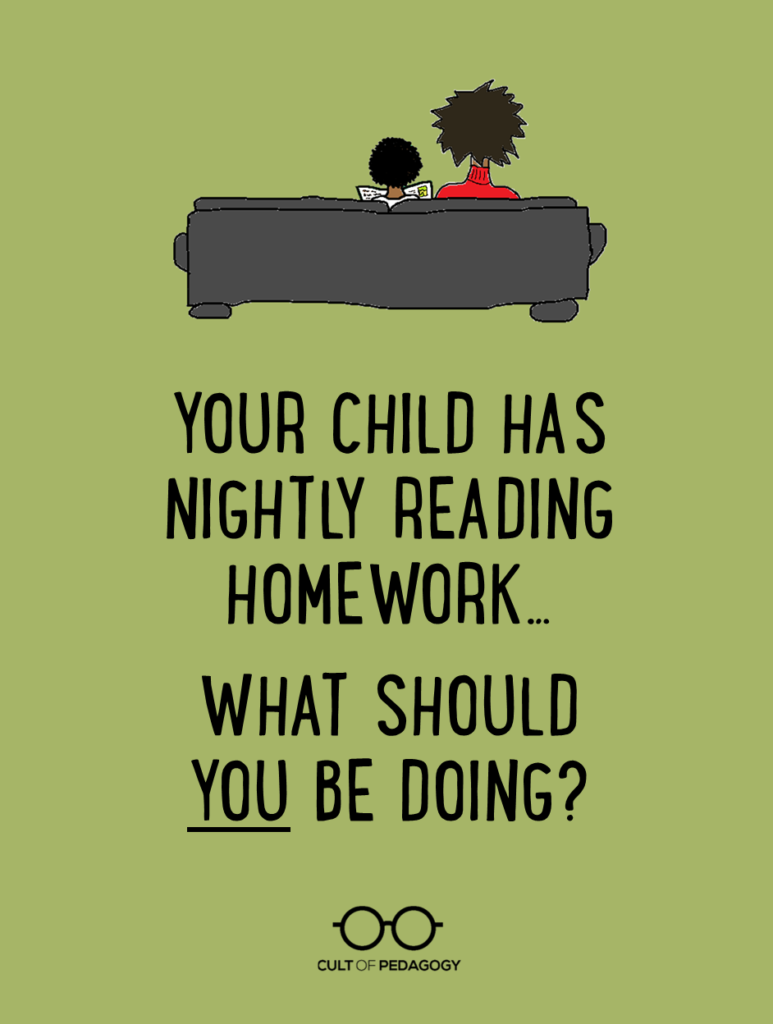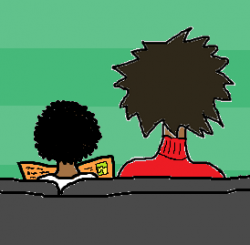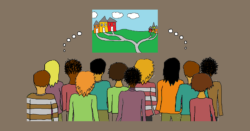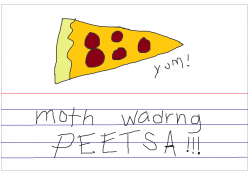
This guest post comes from Carolyn Wilhelm of the Wise Owl Factory.
Kindergarten, first, and second grade teachers often give children a nightly assignment to read aloud for 10 to 20 minutes. This can be supervised by parents, grandparents, or family members. Usually, a certain level of book or page of text is sent home in a reading folder with a chart for recording book titles or length of time spent reading. Here are some tips to help parents understand how best to use the nightly reading time at home.
1. Do not skip this time. A half hour every week does not begin to help as much as a few minutes each day. The long-term effects of skipping nightly reading homework are well established, as described in this article by Edudemic. This fact is well known by teachers who have studied reading pedagogy, and parents can easily find the research online if they need to be convinced.
2. Choose the right time. Always try to find a time when your child will cooperate, when neither of you are pushing to just finish the homework. The best time might not be right after school as some play time may be needed first, and certainly just before bed is not opportune. Find a time that works for you and your family.
 3. Sit side by side with your child. This is not the time to iron or catch up on email. Teachers know what parents are doing during the nightly reading time, if the child starts making up the story as he or she reads aloud to the teacher. This is a clue the parent isn’t watching the words. Children want to please adults and will try their best to sound knowledgeable while reading. If the assignment is to read silently, actually sit by your child and read silently at the same time. Elbow to elbow and knee to knee is the best sitting position.
3. Sit side by side with your child. This is not the time to iron or catch up on email. Teachers know what parents are doing during the nightly reading time, if the child starts making up the story as he or she reads aloud to the teacher. This is a clue the parent isn’t watching the words. Children want to please adults and will try their best to sound knowledgeable while reading. If the assignment is to read silently, actually sit by your child and read silently at the same time. Elbow to elbow and knee to knee is the best sitting position.
4. At the emergent level (when the child is learning sight words, short vowels, and mostly individual letter sounds), allow the child to use all the resources of the book, including pictures. Parents sometimes tell me they are proud of the fact they covered the pictures in emergent readers to force the child to read the “big” words. At this point in early reading, it is not possible to read the big words. The point of emergent readers is to learn sight words, use left to right reading orientation, and realize each word is separate, to utilize the pictures, and to experience reading success. Books that say things such as, “I like the ball, I like the car, I like the bird” are only helping reinforce the words I and like. Here is a link to a free emergent reader printable if you are wondering what they look like.
5. Do not “tell” words at the developing level as the child reads. When the child has progressed from the emergent level to the developing level (learning letter blends, long vowels, and word solving strategies), he or she should be able to stop pointing to words. When children stop dead in the middle of a sentence or paragraph when reading to the teacher, the teacher knows the parents are trying to help by telling the words. Instead, help the child learn to rely on word solving strategies outlined at the end of this blog post.
6. Do not stop reading aloud to your child. It is a mistake to think that now the child can read on his or her own, the parent is out of the picture. Reading aloud to children should continue through grade four or higher. Why? Adults can read such a great variety of stories and expose children to a huge amount of vocabulary that children cannot access on their own. Children need to be reminded that reading is interesting.
7. Discuss what was read. Help your child understand the point of reading is to understand, not just “word call.” Here is a link to my free PDF that explains how parents can help develop their children’s reading comprehension.
This video illustrates some of these concepts:
What is word solving?
This is the missing piece of information for most parents. Because English is not a completely phonetic language, relying on the sound-it-out strategy is not the most effective way to support a child’s reading. To become a fluent reader, more strategies are required. Here are some of them: [For a full description of these strategies, please see my FREE 162 page printable.]
Auto the Otter: This means some words cannot be sounded out and just have to be learned by memory, such as sight words. Good readers need a memorized word bank for automaticity and fluency in reading.
Chunky Monkey: This means to use letter blends and “chunks” of words such as ing, or ed. I remember one mother saying the homework came home for her to help her child chunk the sounds, and she said, “How am I supposed to know what chunking is?” This is really beginning syllabication, but what we say in school is how many times does your mouth open when you say a word like hippopotamus? In that word, your mouth opens five times (five syllables)! A child’s name may have one, two, or three syllables. Of course, we do not expect children to know what that means. We clap as we say words in school, four claps for happy birthday. Also, children can find little words in big words to help them read longer words.
Crabby Connector: This means to make connections between similar words to read a new word. For instance, if you know the word cake, you can more easily read the word lake. Or if you know the word cook, it is easier to connect that to the word cookie, than to completely sound it out over again.
Eagle Eye: This means to look over the entire word. Many times children will stop reading if a word looks difficult, making no attempt to word solve. One trick teachers use is to put a red dot under the middle of the word to get the child to look all the way through the sounds. This will often help the child figure out the word.
Elephant Ears: This means to try a word and see if it makes sense. Sometimes children will read a sentence saying a word that doesn’t fit. We ask, “Did that make sense?” Children need to learn to trust themselves by thinking about the sentence, not just the word. We ask, “What would make sense in this sentence that also begins with that letter?”
Fix-up Bear: Fix-up bear means it is alright to go back and reread and fix an error. We do not have to race through reading just to be done. We read to understand. If we make an error, it should be fixed.
Flippy Dolphin: This is sort of an amazing strategy. If a child reads a long vowel word with a short vowel, or a short vowel word with a long vowel, we say, “Flip the sound.” Somehow children seem to instinctively know to try again with another sound. At the emergent level, though, children do not know the long vowel sounds so this doesn’t apply.
Helpful Kangaroo: This strategy may be used when a few others have been tried without success. It means to ask another person for help!
Lips the Fish: This means to ask a child stuck on a word to get his or her “lips ready” for the first sound. By making an attempt to really notice the first sound, it is often enough for the child to try to finish the word.
Skippy Frog: This strategy is second best to Stretchy Snake. Skippy frog is using context to figure out a word, but what we tell children is to skip the word and keep reading the sentence. Most often, they realize they can figure out the word by using this strategy. They somehow do not think this strategy is OK, so we tell them good readers use Skippy frog, too.
Stretchy Snake: This is the whisper it out strategy. Sound it out uses strong, separate sounds the child is trying to connect together. When we whisper, we naturally connect sounds as they should be connected in reading. It is the best strategy, but it doesn’t work for all words.
Tryin’ Lion: Keep trying! Try another strategy! Try again! Of course, this isn’t for a tired or frustrated reader. Another strategy might be more useful in those cases.
If this one spoke to you, I’d love to have you come back for more. Join my mailing list and get weekly tips, tools, and inspiration—in quick, bite-sized packages—all geared toward making your teaching more effective and joyful. Once you join, you’ll have access to my Members-Only Library of free downloadable resources, including the e-booklet 20 Ways to Cut Your Grading Time in Half. I look forward to getting to know you better!





I love this post!! Bottom line…this has to become a part of the culture of your home. With my daughter, I am working on consistency. We conduct SSR for 20 minutes with a timer. We all have to read and I am working on her dad being a regular participant! My daughter has become competitive with it. She is happy to share that she is in a chapter higher than the one I am in (she is 2nd grade). I let her have those moments. If it motivates her to beat mommy, then so be it! What I really like is it forces me to get back to my personal reading which I seem to sacrifice to lesson planning, grading papers, curating, emailing….something work related. Thanks for this wonderful post.
That sounds awesome, Shayne. When I have been able to do something similar to this (i.e., doing my own actual pleasure reading along with them), I love it. I think for a lot of us, we are good at preaching about reading, but might not walk the walk as often as we’d like our kids to.
Your video is OUTSTANDING, clearly explains, and demonstrates the parent role in nightly reading homework. Your art is wonderful! This is so nice for teachers to share with parents. It will clarity the dilemma of how to help a child improve in reading skills. Thank you so much! Carolyn
Carolyn, thank you! I’m so glad you like it; your article is excellent as well. My hope is that my video along with your article will reach a whole lot of parents. Thanks so much for partnering with me on this!!
That video is fabulous. Is there a way to add it to my class page?
Thank you! Yes, if you contact the tech person in your school, they can probably show you exactly how to embed the video right on your page. If your district blocks YouTube, it won’t work, but you can still put a link to the video on your page.
Here is a direct link to the video on YouTube: http://youtu.be/korfvEOQb14
Here is an article that may help you with the embedding: http://www.htmlgoodies.com/tutorials/web_graphics/article.php/3480061/How-To-Add-a-YouTube-Video-to-Your-Web-Site.htm
Thank you x a million for this information!!
You’re welcome, Carrie!
Thanks so much for this post! I already follow your blog as a middle school educator, but I love these tips for helping my daughter with reading skills as she begins kindergarten this year. It really helps to know exactly what we can and need to do at home to maximize her nightly reading. I’ll be hanging on to this (and sharing it with fellow parents) as she continues to grow as a reader.
Why is reading before bedtime a bad thing? That is our routine. Am I missing something?
My kids read every single night before they go to sleep, and before they could read, I read to them at bedtime every night as well, so I see why you’re asking. I think in this case, the “not before bed” recommendation is referring to the kind of reading the child has to do out loud, with the parent supervising. Reading practice. So it may be more of a struggle. For a child at that stage in their reading skills, you’d want to choose a time when the child is not tired and can handle the challenge of new words. I’d say you still do the reading to them (if that’s the routine) and still encourage them to do their own recreational reading at bedtime, but save the more challenging work for earlier in the day.
What an excellent and essential post! For years, I did the Reading Recovery program with first graders. Repeatedly, I saw that the kids that made the most progress, were the kids who had support at home. However, parents need to learn the strategies outlined in this post in order to provide optimum support to their early readers.
I cannot find the free 162 page printable. Thank you
Hi, Kelly! This is Debbie, a Customer Experience Manager with Cult of Pedagogy. We are contacting the author to see if she can tell us where to find it. Thanks.
Kelly, the link to the free printable in the post has been revised. Thanks for making us aware of the problem!
Jennifer,
Thank you for the video. Have you considered doing a Spanish version? I’d love to share this with our Spanish-speaking families.
Gracias,
What a wonderful idea! That’s not in my plans for the near future, because my Spanish isn’t anywhere close to fluent, but I will keep it in mind for future possibilities!
If you have a child with a learning disability like dyslexia, these strategies are not enough to help your child meet their potential. 1 in 5 kids have dyslexia so it is important to consider why your child might have trouble with reading, spelling, and writing. If you child is falling behind in one of these areas you need to get an evaluation. Your child will also need explicit, structured, evidence-based instruction by a highly-trained teacher. Here are two resources I would recommend for more information: understood.org and dyslexiaida.org.
Excellent video!
Do you have a video with tips for parents of middle school students? Or a handout you’d recommend?
Thank you:j
Hey Jennifer!
Glad you liked the video! I’m not exactly sure what you might be interested in for a middle school reader, but if the student is struggling, I think the tips in the video are still really good to use with a reader of any age. I’d also check out How To Kill the Love of Reading — there might be some really good information that you can apply at home. Pernille Ripp’s Parents: Creating Joyful Reading Routines at Home seemed to have some good suggestions as well. Hope this helps!
Hello!
Do you have anything like this for fourth grade parents?
Thank you!
Hello Alba,
Try checking out Scholastic’s Guide to 4th Grade for parents. In addition to reading activities parents can do with their children, there are also many activity ideas from other subject areas listed on the website.
My son who’s about to be in second grade is having a hard time reading. I’m glad you shared this; I’ll keep in mind to let him read books that consist of pictures. This is quite a challenge that’s why I aim to find the right reading curriculum for him.
I love your videos and podcast! I’m found them so helpful! I am curious if you do all the art yourself in these videos? I’d love to make my ed videos look this polished!
Hi Amanda! Yes, Jenn does all her own illustrations. Check out the FAQs and Behind the Scenes pages for details. Hope this helps!
Hope this helps!